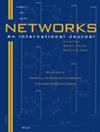风险规避优化和弹性网络流
IF 1.3
4区 计算机科学
Q4 COMPUTER SCIENCE, HARDWARE & ARCHITECTURE
引用次数: 1
摘要
我们提出了一种构建网络弹性指标的方法,其中弹性被理解为网络在拓扑结构或操作参数发生意外(随机)中断后恢复其最优或接近最优操作的适应性,并以弹性最大网络流量问题和弹性最小代价网络问题为例进行了说明。具体而言,这些问题中的网络流是为抵御网络承载能力的不可预测损失而设计的,并且获得一定程度的弹性的机制是通过预先分配资源来(至少部分)恢复弧的容量。所获得的弹性网络流问题的公式具有许多有用的性质,例如,与标准网络流问题类似,如果电弧容量、成本等是积分的,则网络流是积分的。研究还表明,所提出的弹性网络流问题的公式可以被视为“风险的网络度量”,在性质和行为上类似于风险的凸度量。针对弹性最大网络流量问题和弹性最小成本网络流量问题,提出了有效的分解算法,并在具有三种拓扑类型的网络上研究了网络流量弹性作为网络结构的函数:均匀随机图、无标度图和网格图。本文章由计算机程序翻译,如有差异,请以英文原文为准。
Risk‐averse optimization and resilient network flows
We propose an approach to constructing metrics of network resilience, where resilience is understood as the network's amenability to restoring its optimal or near‐optimal operations subsequent to unforeseen (stochastic) disruptions of its topology or operational parameters, and illustrated it on the examples of the resilient maximum network flow problem and the resilient minimum cost network problem. Specifically, the network flows in these problems are designed for resilience against unpredictable losses of network carrying capacity, and the mechanism of attaining a degree of resilience is through preallocation of resources toward (at least partial) restoration of the capacities of the arcs. The obtained formulations of resilient network flow problems possess a number of useful properties, for example, similarly to the standard network flow problems, the network flow is integral if the arc capacities, costs, and so forth, are integral. It is also shown that the proposed formulations of resilient network flow problems can be viewed as “network measures of risk”, similar in properties and behavior to convex measures of risk. Efficient decomposition algorithms have been proposed for both the resilient maximum network flow problem and the resilient minimum cost network flow problem, and a study of the network flow resilience as a function of network's structure has been conducted on networks with three types of topology: that of uniform random graphs, scale‐free graphs, and grid graphs.
求助全文
通过发布文献求助,成功后即可免费获取论文全文。
去求助
来源期刊

Networks
工程技术-计算机:硬件
CiteScore
4.40
自引率
9.50%
发文量
46
审稿时长
12 months
期刊介绍:
Network problems are pervasive in our modern technological society, as witnessed by our reliance on physical networks that provide power, communication, and transportation. As well, a number of processes can be modeled using logical networks, as in the scheduling of interdependent tasks, the dating of archaeological artifacts, or the compilation of subroutines comprising a large computer program. Networks provide a common framework for posing and studying problems that often have wider applicability than their originating context.
The goal of this journal is to provide a central forum for the distribution of timely information about network problems, their design and mathematical analysis, as well as efficient algorithms for carrying out optimization on networks. The nonstandard modeling of diverse processes using networks and network concepts is also of interest. Consequently, the disciplines that are useful in studying networks are varied, including applied mathematics, operations research, computer science, discrete mathematics, and economics.
Networks publishes material on the analytic modeling of problems using networks, the mathematical analysis of network problems, the design of computationally efficient network algorithms, and innovative case studies of successful network applications. We do not typically publish works that fall in the realm of pure graph theory (without significant algorithmic and modeling contributions) or papers that deal with engineering aspects of network design. Since the audience for this journal is then necessarily broad, articles that impact multiple application areas or that creatively use new or existing methodologies are especially appropriate. We seek to publish original, well-written research papers that make a substantive contribution to the knowledge base. In addition, tutorial and survey articles are welcomed. All manuscripts are carefully refereed.
 求助内容:
求助内容: 应助结果提醒方式:
应助结果提醒方式:


